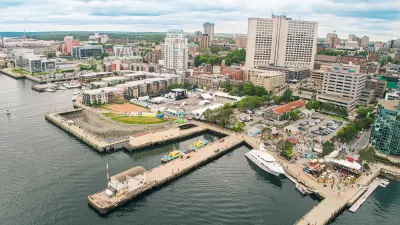How small, incremental changes can create vibrant places.

In an article for Happy Cities, Tristan Cleveland describes the transformation of the Halifax waterfront from a declining post-industrial area to a vibrant hub of public space and amenities that now attracts over 100,000 visitors per year, despite its somewhat inconvenient location.
Cleveland describes the efforts of Build Nova Scotia to improve the waterfront and make it more welcoming to the public, which include simple, affordable steps like adding public furniture and kiosks for small businesses. “Every corner offers a half-dozen things to do—thanks to the cumulative impact of decades of small investments.”
Cleveland contrasts the success of the Waterfront with Halifax Commons, a vast green space in the middle of the city that is easily accessible but often underused. The difference, for Cleveland, is the small things. Although the city has big plans for the future of the park, “It is not currently anyone’s job to ask, each spring, whether any areas of the park are underused, and what can be done to bring life to them.”
This underscores a common problem in park planning. “Cities tend to make major investments in headline projects, but struggle to spend on small, cheap projects.” Cleveland argues that these small, incremental investments in placemaking “need not be expensive, and they generate disproportionate value in new developments and businesses.”
FULL STORY: How Halifax built the most vibrant waterfront in Canada: Decades of small changes

Planetizen Federal Action Tracker
A weekly monitor of how Trump’s orders and actions are impacting planners and planning in America.

Maui's Vacation Rental Debate Turns Ugly
Verbal attacks, misinformation campaigns and fistfights plague a high-stakes debate to convert thousands of vacation rentals into long-term housing.

Restaurant Patios Were a Pandemic Win — Why Were They so Hard to Keep?
Social distancing requirements and changes in travel patterns prompted cities to pilot new uses for street and sidewalk space. Then it got complicated.

In California Battle of Housing vs. Environment, Housing Just Won
A new state law significantly limits the power of CEQA, an environmental review law that served as a powerful tool for blocking new development.

Boulder Eliminates Parking Minimums Citywide
Officials estimate the cost of building a single underground parking space at up to $100,000.

Orange County, Florida Adopts Largest US “Sprawl Repair” Code
The ‘Orange Code’ seeks to rectify decades of sprawl-inducing, car-oriented development.
Urban Design for Planners 1: Software Tools
This six-course series explores essential urban design concepts using open source software and equips planners with the tools they need to participate fully in the urban design process.
Planning for Universal Design
Learn the tools for implementing Universal Design in planning regulations.
Heyer Gruel & Associates PA
JM Goldson LLC
Custer County Colorado
City of Camden Redevelopment Agency
City of Astoria
Transportation Research & Education Center (TREC) at Portland State University
Jefferson Parish Government
Camden Redevelopment Agency
City of Claremont





























